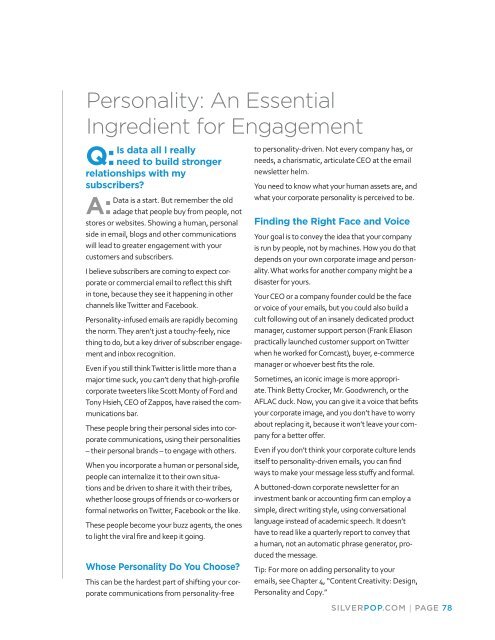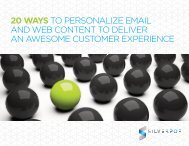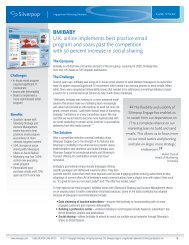eBook - Silverpop
eBook - Silverpop
eBook - Silverpop
Create successful ePaper yourself
Turn your PDF publications into a flip-book with our unique Google optimized e-Paper software.
Personality: An Essential<br />
Ingredient for Engagement<br />
Is data all I really<br />
Q: need to build stronger<br />
relationships with my<br />
subscribers?<br />
Data is a start. But remember the old<br />
A: adage that people buy from people, not<br />
stores or websites. Showing a human, personal<br />
side in email, blogs and other communications<br />
will lead to greater engagement with your<br />
customers and subscribers.<br />
I believe subscribers are coming to expect corporate<br />
or commercial email to reflect this shift<br />
in tone, because they see it happening in other<br />
channels like Twitter and Facebook.<br />
Personality-infused emails are rapidly becoming<br />
the norm. They aren’t just a touchy-feely, nice<br />
thing to do, but a key driver of subscriber engagement<br />
and inbox recognition.<br />
Even if you still think Twitter is little more than a<br />
major time suck, you can’t deny that high-profile<br />
corporate tweeters like Scott Monty of Ford and<br />
Tony Hsieh, CEO of Zappos, have raised the communications<br />
bar.<br />
These people bring their personal sides into corporate<br />
communications, using their personalities<br />
– their personal brands – to engage with others.<br />
When you incorporate a human or personal side,<br />
people can internalize it to their own situations<br />
and be driven to share it with their tribes,<br />
whether loose groups of friends or co-workers or<br />
formal networks on Twitter, Facebook or the like.<br />
These people become your buzz agents, the ones<br />
to light the viral fire and keep it going.<br />
Whose Personality Do You Choose?<br />
This can be the hardest part of shifting your corporate<br />
communications from personality-free<br />
to personality-driven. Not every company has, or<br />
needs, a charismatic, articulate CEO at the email<br />
newsletter helm.<br />
You need to know what your human assets are, and<br />
what your corporate personality is perceived to be.<br />
Finding the Right Face and Voice<br />
Your goal is to convey the idea that your company<br />
is run by people, not by machines. How you do that<br />
depends on your own corporate image and personality.<br />
What works for another company might be a<br />
disaster for yours.<br />
Your CEO or a company founder could be the face<br />
or voice of your emails, but you could also build a<br />
cult following out of an insanely dedicated product<br />
manager, customer support person (Frank Eliason<br />
practically launched customer support on Twitter<br />
when he worked for Comcast), buyer, e-commerce<br />
manager or whoever best fits the role.<br />
Sometimes, an iconic image is more appropriate.<br />
Think Betty Crocker, Mr. Goodwrench, or the<br />
AFLAC duck. Now, you can give it a voice that befits<br />
your corporate image, and you don’t have to worry<br />
about replacing it, because it won’t leave your company<br />
for a better offer.<br />
Even if you don’t think your corporate culture lends<br />
itself to personality-driven emails, you can find<br />
ways to make your message less stuffy and formal.<br />
A buttoned-down corporate newsletter for an<br />
investment bank or accounting firm can employ a<br />
simple, direct writing style, using conversational<br />
language instead of academic speech. It doesn’t<br />
have to read like a quarterly report to convey that<br />
a human, not an automatic phrase generator, produced<br />
the message.<br />
Tip: For more on adding personality to your<br />
emails, see Chapter 4, “Content Creativity: Design,<br />
Personality and Copy.”<br />
SILVERPOP.COM | PAGE 78







